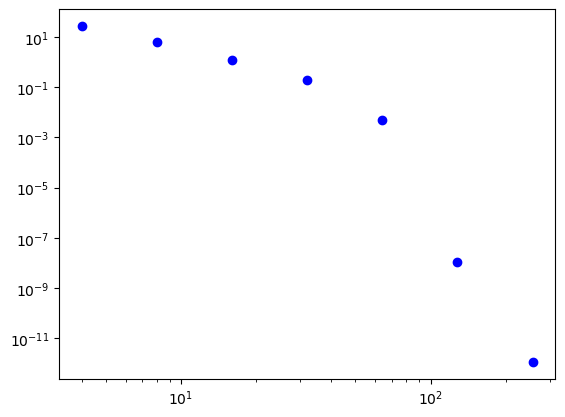3. Suggested solutions weekly assignments - lecture 11#
Solve the inhomogeneous Helmholtz equation
using the manufactured solution \(u(x)=(1-x^2)\exp(\cos(x-0.5))\) and \(\alpha=0.1\). Try also to remove \(1-x^2\) and solve the same problem with inhomogeneous boundary conditions. Plot both the solution and the \(L^2\) error.
Using first shenfun
import matplotlib.pyplot as plt
from shenfun import *
import sympy as sp
x = sp.Symbol('x')
def solve(N, ue, family='Legendre', alpha=sp.Rational(1, 10)):
V = FunctionSpace(N, family=family, bc=(ue.subs(x, -1), ue.subs(x, 1)))
f = ue.diff(x, 2) + alpha*ue
u = TrialFunction(V)
v = TestFunction(V)
A = inner(Dx(u, 0, 2)+alpha*u, v)
b = inner(f, v)
uN = la.Solver(A)(b)
return uN
ue = (1-x**2)*sp.exp(sp.cos(x-sp.S.Half))
uN = solve(20, ue)
uj = uN.backward()
xj = uN.function_space().mesh()
plt.plot(xj, uj, 'b', xj, sp.lambdify(x, ue)(xj), 'ro')
plt.legend([uN.function_space().family(), 'Exact']);

Compute L2-error and plot it to show the spectral accuracy. Both for Legendre and Chebyshev. Note that with Chebyshev shenfun automatically chooses a weighted inner product with weight \(1/\sqrt{1-x^2}\).
def L2_error(uN, ul):
domain = uN.function_space().domain
xj = np.linspace(domain[0], domain[1], len(uN)*10)
uj = uN(xj)
uej = ul(xj)
return np.sqrt(np.trapz((uj-uej)**2, dx=xj[1]-xj[0]))
ue = (1-x**2)*sp.exp(sp.cos(x-sp.S.Half))
ul = sp.lambdify(x, ue)
error = {}
for family in ('Chebyshev', 'Legendre'):
error[family] = []
for N in 2**np.arange(2, 6):
uN = solve(N, ue)
error[family].append(L2_error(uN, ul))
/var/folders/ql/nly59sfj4dd3spkth6lk0kjw0000gn/T/ipykernel_2794/2384630451.py:6: DeprecationWarning: `trapz` is deprecated. Use `trapezoid` instead, or one of the numerical integration functions in `scipy.integrate`.
return np.sqrt(np.trapz((uj-uej)**2, dx=xj[1]-xj[0]))
plt.loglog(2**np.arange(2, 6), error['Legendre'], 'bo',
2**np.arange(2, 6), error['Chebyshev'], 'r+');
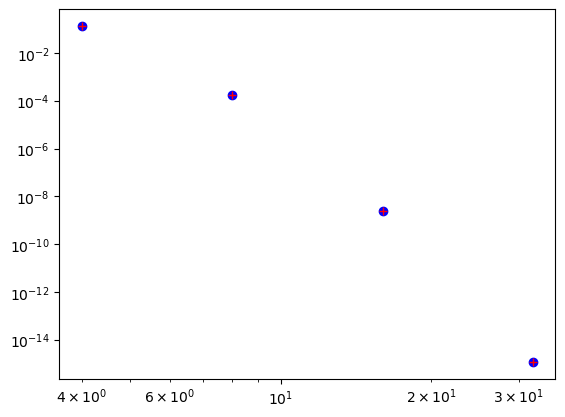
Now do the same thing with inhomogeneous boundary conditions. The accuracy should be approximately the same.
ue = sp.exp(sp.cos(x-sp.S.Half))
ul = sp.lambdify(x, ue)
error2 = {}
for family in ('Chebyshev', 'Legendre'):
error2[family] = []
for N in 2**np.arange(2, 6):
uN = solve(N, ue)
error2[family].append(L2_error(uN, ul))
/var/folders/ql/nly59sfj4dd3spkth6lk0kjw0000gn/T/ipykernel_2794/2384630451.py:6: DeprecationWarning: `trapz` is deprecated. Use `trapezoid` instead, or one of the numerical integration functions in `scipy.integrate`.
return np.sqrt(np.trapz((uj-uej)**2, dx=xj[1]-xj[0]))
plt.loglog(2**np.arange(2, 6), error2['Legendre'], 'bo',
2**np.arange(2, 6), error2['Chebyshev'], 'r+');

Note that the solution now contains the boundary conditions. In Shenfun the two boundary conditions of the inhomogeneous Dirichlet space are stored in the last two items of the array of unknowns uN.
uN = solve(20, ue)
print(uN[-2:])
[1.07329913 2.40507854]
The exact boundary values are:
print(ue.subs(x, -1).n(), ue.subs(x, 1).n())
1.07329912758172 2.40507854457258
Now solve the same problem using collocation. Implement by modifying some code from lecture 11.
from lagrange import PolyDerivative
from scipy.interpolate import BarycentricInterpolator
def Helmholtz_coll(N, f, xj, bc=(0, 0), alpha=0.1):
D = PolyDerivative(xj, 2) # Get second derivative matrix
M = np.eye(N+1)
A = D + alpha*M
A[0, 0] = 1; A[0, 1:] = 0 # ident first row
A[-1, -1] = 1; A[-1, :-1] = 0 # ident last row
fh = np.zeros(N+1)
fh[1:-1] = sp.lambdify(x, f)(xj[1:-1])
fh[0], fh[-1] = bc # Fix boundary conditions
uh = np.linalg.solve(A, fh)
return uh
def l2_error(uh, ul, xj):
N = len(uh)-1
L = BarycentricInterpolator(xj, yi=uh)
N = 4*len(uh)
xj = np.linspace(xj[0], xj[-1], N+1)
return np.sqrt(np.trapz((ul(xj)-L(xj).astype(float))**2, dx=2./N))
ue = sp.exp(sp.cos(x-sp.S.Half))
ul = sp.lambdify(x, ue)
alpha = 0.1
f = ue.diff(x, 2) + alpha*ue
bc = ue.subs(x, -1), ue.subs(x, 1)
err = []
for N in 2**np.arange(2, 6):
xj = np.cos(np.arange(N+1)*np.pi/N)[::-1]
uh = Helmholtz_coll(N, f, xj, bc=bc, alpha=alpha)
err.append(l2_error(uh, ul, xj))
/var/folders/ql/nly59sfj4dd3spkth6lk0kjw0000gn/T/ipykernel_2794/2760787852.py:21: DeprecationWarning: `trapz` is deprecated. Use `trapezoid` instead, or one of the numerical integration functions in `scipy.integrate`.
return np.sqrt(np.trapz((ul(xj)-L(xj).astype(float))**2, dx=2./N))
plt.loglog(2**np.arange(2, 6), err, 'bo')
[<matplotlib.lines.Line2D at 0x16903d850>]
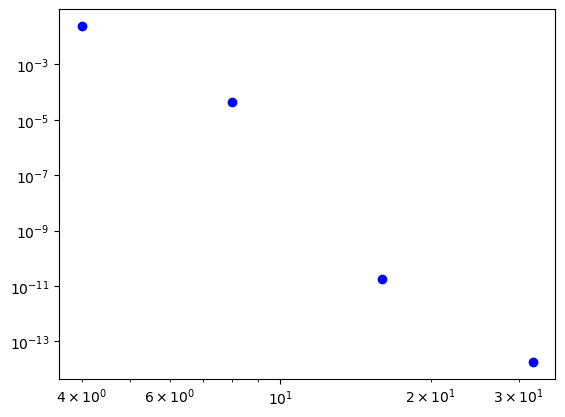
Solve the convection-diffusion equation in the domain \(x \in [0, 1]\) and vary the parameter \(\epsilon\) such that \(\epsilon \in (1, 0.1, 0.01, 0.001)\):
The exact solution is here
For this problem we create a new shenfun solver, where the right hand side is simply zero. Test first with a relatively large epsilon:
def solveCD(N, ue, family='Legendre', epsilon=sp.Rational(1, 10)):
V = FunctionSpace(N, family=family, bc=(ue.subs(x, 0), ue.subs(x, 1)), domain=(0, 1))
u = TrialFunction(V)
v = TestFunction(V)
A = inner(Dx(u, 0, 2)+1/epsilon*Dx(u, 0, 1), v)
b = Function(V)
uN = la.Solver(A)(b)
return uN
epsilon = sp.Rational(1, 10)
ue = lambda epsilon: (sp.exp(-x/epsilon)-1) / (sp.exp(-1/epsilon)-1)
uN = solveCD(20, ue(epsilon), epsilon=epsilon.n())
uj = uN.backward()
xj = uN.function_space().mesh()
plt.plot(xj, uj, 'b', xj, sp.lambdify(x, ue(epsilon))(xj), 'ro')
plt.legend([uN.function_space().family(), 'Exact']);
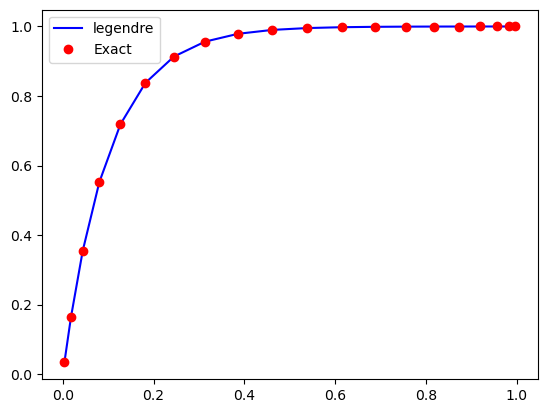
Now check convergence for the most stiff epsilon=1/1000. For this we need quite a few degrees of freedom in order to resolve the sharp gradient of \(u(x)\).
error = {}
epsilon = sp.Rational(1, 1000)
ul = sp.lambdify(x, ue(epsilon))
for family in ('Chebyshev', 'Legendre'):
error[family] = []
for N in 2**np.arange(2, 9):
uN = solveCD(N, ue(epsilon), epsilon=epsilon.n())
error[family].append(L2_error(uN, ul))
/var/folders/ql/nly59sfj4dd3spkth6lk0kjw0000gn/T/ipykernel_2794/2384630451.py:6: DeprecationWarning: `trapz` is deprecated. Use `trapezoid` instead, or one of the numerical integration functions in `scipy.integrate`.
return np.sqrt(np.trapz((uj-uej)**2, dx=xj[1]-xj[0]))
plt.loglog(2**np.arange(2, 9), error['Legendre'], 'bo',
2**np.arange(2, 9), error['Chebyshev'], 'r+');
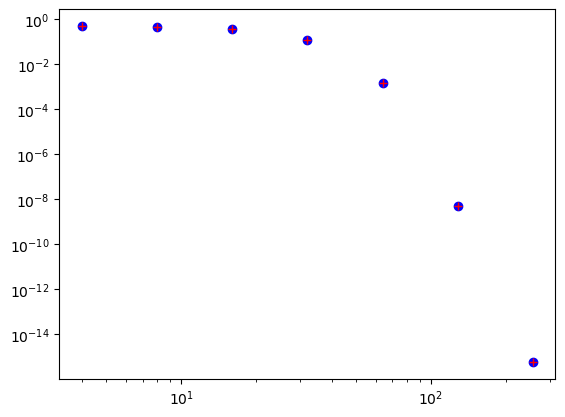
Now solve the same equation using collocation.
def CD_coll(N, xj, bc=(0, 0), epsilon=0.1):
D2 = PolyDerivative(xj, 2) # Get second derivative matrix
D1 = PolyDerivative(xj, 1) # Get second derivative matrix
A = D2 + 1/epsilon*D1
A[0, 0] = 1; A[0, 1:] = 0 # ident first row
A[-1, -1] = 1; A[-1, :-1] = 0 # ident last row
fh = np.zeros(N+1)
fh[0], fh[-1] = bc # Fix boundary conditions
uh = np.linalg.solve(A, fh)
return uh
err = []
for N in 2**np.arange(2, 9):
xj = (np.cos(np.arange(N+1)*np.pi/N)[::-1]+1)/2 # Get mesh on [0, 1]
uh = CD_coll(N, xj, bc=(0, 1), epsilon=float(epsilon))
err.append(l2_error(uh, ul, xj))
/var/folders/ql/nly59sfj4dd3spkth6lk0kjw0000gn/T/ipykernel_2794/2760787852.py:21: DeprecationWarning: `trapz` is deprecated. Use `trapezoid` instead, or one of the numerical integration functions in `scipy.integrate`.
return np.sqrt(np.trapz((ul(xj)-L(xj).astype(float))**2, dx=2./N))
plt.loglog(2**np.arange(2, 9), err, 'bo');
